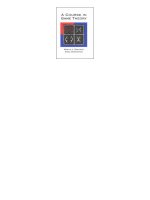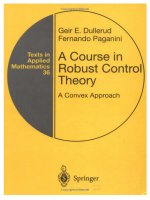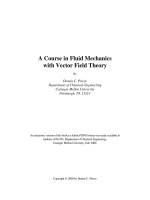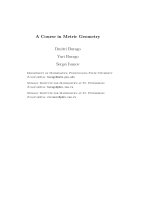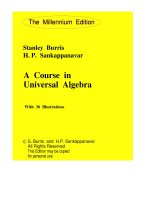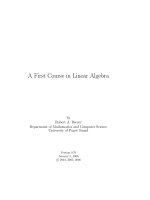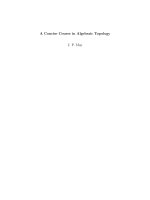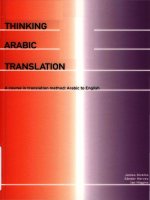A course in homological algebra, peter j hilton, urs stammbach
Bạn đang xem bản rút gọn của tài liệu. Xem và tải ngay bản đầy đủ của tài liệu tại đây (27.18 MB, 376 trang )
Graduate Texts in Mathematics
4
Editorial Board
S. Axler
Springer
Science+Business
Media,
LLC
F.W. Gehring
P.R. Halmos
Graduate Texts in Mathematics
T AKEUTIIZARING. Introduction to
Axiomatic Set Theory. 2nd ed.
2 OXTOBY. Measure and Category. 2nd ed.
3 SCHAEFER. Topological Vector Spaces.
4 HILTON/STAMMBACH. A Course in
Homological Algebra. 2nd ed.
5 MAC LANE. Categories for the Working
Mathematician.
6 HUGHES/PIPER. Projective Planes.
7 SERRE. A Course in Arithmetic.
8 TAKEUTIIZARING. Axiomatic Set Theory.
9 HUMPHREYS. Introduction to Lie Algebras
and Representation Theory.
10 COHEN. A Course in Simple Homotopy
Theory.
11 CONWAY. Functions of One Complex
Variable I. 2nd ed.
12 BEALS. Advanced Mathematical Analysis.
13 ANDERSON/FuLLER. Rings and Categories
of Modules. 2nd ed.
14 GOLUBITSKy/GUILLEMIN. Stable Mappings
and Their Singularities.
15 BERBERIAN. Lectures in Functional
Analysis and Operator Theory.
16 WINTER. The Structure of Fields.
17 ROSENBLATT. Random Processes. 2nd ed.
18 HALMOS. Measure Theory.
19 HALMOS. A Hilbert Space Problem Book.
2nd ed.
20 HUSEMOLLER. Fibre Bundles. 3rd ed.
21 HUMPHREYS. Linear Algebraic Groups.
22 BARNES/MACK. An Algebraic Introduction
to MathematicaJ Logic.
23 GREUB. Linear Algebra. 4th ed.
24 HOLMES. Geometric Functional Analysis
and Its Applications.
25 HEWITT/STROMBERG. Real and Abstract
Analysis.
26 MANES. Algebraic Theories.
27 KELLEY. General Topology.
28 ZARIsKiiSAMUEL. Commutative Algebra.
Vol.I.
29 ZARISKIISAMUEL. Commutative Algebra.
Vol.Il.
30 JACOBSON. Lectures in Abstract Algebra I.
Basic Concepts.
31 JACOBSON. Lectures in Abstract Algebra
II. Linear Algebra.
32 JACOBSON. Lectures in Abstract Algebra
Ill. Theory of Fields and GaJois Theory.
33 HIRSCH. Differential Topology.
34 SPITZER. Principles of Random Walk.
2nd ed.
35 WERMER. Banach Algebras and Several
Complex Variables. 2nd ed.
36 KELLEy/NAMIOKA et al. Linear
Topological Spaces.
37 MONK. Mathematical Logic.
38 GRAUERT/FRITZSCHE. Several Complex
Variables.
39 ARYESON. An Invitation to C*-Algebras.
40 KEMENy/SNELL/KNAPP. Denumerable
Markov Chains. 2nd ed.
41 ApoSTOL. Modular Functions and
Dirichlet Series in Number Theory.
2nd ed.
42 SERRE. Linear Representations of Finite
Groups.
43 GILLMAN/JERISON. Rings of Continuous
Functions.
44 KENDIG. Elementary Algebraic Geometry.
45 LOEVE. Probability Theory I. 4th ed.
46 LOEVE. Probability Theory II. 4th ed.
47 MOISE. Geometric Topology in
Dimensions 2 and 3.
48 SACHS/WU. General Relativity for
Mathematicians.
49 GRUENBERG/WEIR. Linear Geometry.
2nd ed.
50 EDWARDS. Fermat's Last Theorem.
51 KLINGENBERG. A Course in Differential
Geometry.
52 HARTSHORNE. Algebraic Geometry.
53 MANIN. A Course in Mathematical Logic.
54 GRA VERIWATKINS. Combinatorics with
Emphasis on the Theory of Graphs.
55 BROWN/PEARCY. Introduction to Operator
Theory I: Elements of Functional
Analysis.
56 MASSEY. Algebraic Topology: An
Introduction.
57 CROWELL/Fox. Introduction to Knot
Theory.
58 KOBLITZ. p-adic Numbers, p-adic
Analysis, and Zeta-Functions. 2nd ed.
59 LANG. Cyclotomic Fields.
60 ARNOLD. Mathematical Methods in
Classical Mechanics. 2nd ed.
continued after index
P.J. Hilton
U. Stammbach
A Course in
Homological Algebra
Second Edition
,
Springer
Peter J. Hilton
Department of Mathematical Sciences
State University of New York
Binghamton, NY 13902-6000
USA
Urs Stammbach
Mathematik
ETH-Zentrum
CH-8092 Ziirich
Switzerland
and
Department of Mathematics
University of Central Florida
Orlando, FL 32816
USA
Editorial Board
S. Axler
Department of
Mathematics
Michigan State University
East Lansing, MI 48824
USA
F.W. Gehring
Department of
Mathematics
University of Michigan
Ann Arbor, MI 48109
USA
P.R. Halmos
Department of
Mathematics
Santa Clara University
Santa Clara, CA 95053
USA
Mathematics Subject Classification (1991): 18Axx, 18Gxx, 13Dxx, 16Exx, 55Uxx
Library of Congress Cataloging-in-Publication Data
Hilton, Peter John.
A course in homological algebra / P.J. Hilton, U. Stammbach.2nd ed.
p. cm.-(Graduate texts in mathematics ;4)
Includes bibliographical references and index.
ISBN 978-14612-6438-5
ISBN 978-1-4419-8566-8 (eBook)
DOI 10.1007/978-14419-8566-8
1. Algebra, Homological.
III. Series.
QA169.H55 1996
512'.55-dc20
1. Stammbach, Urs.
II. Title.
96-24224
Printed on acid-free paper.
© 1997 Springer Science+Business Media New York
Originally published by Springer-Verlag New York, lnc. in 1997
Softcover reprint of the hardcover 2nd edition 1997
All rights reserved. This work may not be translated or copied in whole or in part without
the written permission ofthe publisher (Springer-Verlag New York, Inc., 175 Fifth Avenue,
New York, NY 10010, USA), except for brief excerpts in connection with reviews or scholarly analysis. Use in connection with any form of information storage and retrieval, electronic adaptation, computer software, or by similar or dissimilar methodology now known
or hereafter developed is forbidden.
The use of general descriptive names, trade names, trademarks, etc., in this publication, even
if the former are not especially identified, is not to be taken as a sign that such names, as
understood by the Trade Marks and Merchandise Marks Act, may accordingly be used
freely by anyone.
Production managed by Francine McNeil1; manufacturing supervised by Jacqui Ashri.
Typeset by Asco Trade Typesetting Ltd., Hong Kong.
9 8 7 6 5 432 1
ISBN 978-14612-6438-5
SPIN 10541600
To Margaret and Irene
Preface to the Second Edition
We have inserted, in this edition, an extra chapter (Chapter X) entitled
"Some Applications and Recent Developments." The first section of this
chapter describes how homological algebra arose by abstraction from
algebraic topology and how it has contributed to the knowledge of
topology. The other four sections describe applications of the methods
and results of homological algebra to other parts of algebra. Most of the
material presented in these four sections was not available when this text
was first published. Naturally, the treatments in these five sections are
somewhat cursory, the intention being to give the flavor of the homological methods rather than the details of the arguments and results.
We would like to express our appreciation of help received in writing
Chapter X; in particular, to Ross Geoghegan and Peter Kropholler
(Section 3), and to Jacques Thevenaz (Sections 4 and 5).
The only other changes consist of the correction of small errors and,
of course, the enlargement of the Index.
Binghamton, New York, USA
Zurich, Switzerland
Peter Hilton
Urs Stammbach
Contents
Preface to the Second Edition
vii
Introduction. .
I.
Modules.
1. Modules. . . . . . . . . . .
2.
3.
4.
5.
6.
7.
8.
9.
II.
The Group of Homomorphisms .
Sums and Products . . . . . .
Free and Projective Modules . .
Projective Modules over a Principal Ideal Domain.
Dualization, Injective Modules . . . . . . . .
Injective Modules over a Principal Ideal Domain
Cofree Modules. . .
Essential Extensions. . . . . . . . . . . . .
Categories and Functors
1. Categories
2.
3.
4.
5.
6.
7.
8.
9.
10.
III.
Functors . . . . .
Duality . . . . .
Natural Transformations.
Products and Coproducts ; Universal Constructions
Universal Constructions (Continued); Pull-backs
and Push-outs . . . . . . . . . . . . . .
Adjoint Functors . . . . . . . . . . . . .
Adjoint Functors and Universal Constructions
Abelian Categories . . . . . . . .
Projective, Injective, and Free Objects . . . .
10
11
16
18
22
26
28
31
34
36
40
40
44
48
. 50
54
59
63
69
74
81
Extensions of Modules .
84
1. Extensions. . . .
84
2. The Functor Ext .
3. Ext Using Injectives .
4. Computation of some Ext-Groups.
94
97
89
Contents
x
5.
6.
7.
8.
IV.
V.
Two Exact Sequences . . . . . . . . . . .
A Theorem of Stein-Serre for Abelian Groups .
The Tensor Product .
The Functor Tor . . . . . . . . . . . . .
112
Derived Functors . . . . . . . . . . . . '. '
116
1.
2.
3.
4.
5.
6.
7.
8.
9.
10.
11.
12.
117
121
124
126
130
136
139
143
148
156
160
162
Complexes. . . . . . . . . . . . . .
The Long Exact (Co) Homology Sequence .
Homotopy. . .
Resolutions. . . . . . . . . . . . . .
Derived Functors . . . . . . . . . . .
The Two Long Exact Sequences of Derived Functors .
The Functors Ext~ Using Projectives .
The Functors Ext~ Using Injectives . . . . .
Ext" and n-Extensions . . . . . . . . . . .
Another Characterization of Derived Functors
The Functor Tor~ .
Change of Rings . . . . . . . . . . . . .
The Kiinneth Formula
1.
2.
3.
4.
VI.
99
106
109
Double Complexes . .
The K iinneth Theorem.
The Dual Kiinneth Theorem
Applications of the Kiinneth Formulas.
Cohomology of Groups. . . . .
1.
2.
3.
4.
5.
6.
7.
8.
9.
10.
11.
12.
13.
14.
The Group Ring . . . . .
Definition of (Co) Homology
HO , Ho . . . . . . . . . .
HI, HI with Trivial Coefficient Modules
The Augmentation Ideal, Derivations, and the
Semi-Direct Product . . . . . . . . . .
A Short Exact Sequence . . . . . . . . .
The (Co) Homology of Finite Cyclic Groups.
The 5-Term Exact Sequences . . . . . . .
H 2 , Hopfs Formula, and the Lower Central Series.
H2 and Extensions . . . . . . . . . .
Relative Projectives and Relative Injectives
Reduction Theorems. . . . . . .
Resolutions . . . . . . . . . .
The (Co) Homology ofa Coproduct
166
167
172
177
180
184
186
188
191
192
194
197
200
202
204
206
210
213
214
219
Contents
15. The Universal Coefficient Theorem and the
(Co) Homology of a Product
16. Groups and Subgroups . . . . . . . . .
VII. Cohomology of Lie Algebras
1. Lie Algebras and their Universal Enveloping Algebra .
Definition of Cohomology; HO , HI. .
2.
3.
4.
5.
6.
7.
H2 and Extensions . . . . . . . .
A Resolution of the Ground Field K .
Semi-simple Lie Algebras . . . . .
The two Whitehead Lemmas . . . .
Appendix: Hilbert's Chain-of-Syzygies Theorem
VIII. Exact Couples and Spectral Sequences . .
1. Exact Couples and Spectral Sequences
2. Filtered Differential Objects . . . .
3. Finite Convergence Conditions for Filtered Chain
Complexes. . . . . . . . .
4. The Ladder of an Exact Couple . . .
5. Limits. . . . . . . . . . . . . .
6. Rees Systems and Filtered Complexes
7. The Limit of a Rees System. . . . .
8. Completions of Filtrations . . . . .
9. The Grothendieck Spectral Sequence .
XI
221
223
229
229
234
237
239
244
247
251
255
256
261
265
269
276
281
288
291
297
IX. Satellites and Homology . . . . . . .
306
1. Projective Classes of Epimorphisms
307
309
312
318
320
2.
3.
4.
5.
6.
X.
6"-Derived Functors . . . . . . .
6"-Satellites. . . . . . . . . . .
The Adjoint Theorem and Examples.
Kan Extensions and Homology . . .
Applications: Homology of Small Categories,
Spectral Sequences . . . . . . . . . . .
327
Some Applications and Recent Developments . .
331
1. Homological Algebra and Algebraic Topology.
331
335
339
344
349
2.
3.
4.
5.
Nilpotent Groups. . . . . . .
Finiteness Conditions on Groups
Modular Representation Theory.
Stable and Derived Categories. .
Xll
Contents
Bibliography
357
Index
359
Introduction *
This book arose out of a course of lectures given at the Swiss Federal
Institute of Technology (ETH), Zurich, in 1966-67. The course was
first set down as a set of lecture notes, and, in 1968, Professor Eckmann
persuaded the authors to build a graduate text out of the notes, taking
account, where appropriate, of recent developments in the subject.
The level and duration of the original course corresponded essentially
to that ofa year-long, first-year graduate course at an American university.
The background assumed of the student consisted of little more than the
algebraic theories of finitely-generated abelian groups and of vector
spaces over a field . In particular, he was not supposed to have had any
formal instruction in categorical notions beyond simply some understanding of the basic terms employed (category, functor, natural transformation). On the other hand, the student was expected to have some
sophistication and some preparation for rather abstract ideas. Further,
no knowledge of algebraic topology was assumed, so that such notions
as chain-complex, chain-map, chain-homotopy, homology were not
already available and had to be introduced as purely algebraic constructs.
Although references to relevant ideas in algebraic topology do feature in
this text, as they did in the course, they are in the nature of (two-way)
motivational enrichment, and the student is not left to depend on any
understanding of topology to provide a justification for presenting a given
topic.
The level and knowledge assumed of the student explains the order
of events in the opening chapters. Thus, Chapter I is devoted to the theory
of modules over a unitary ring A. In this chapter, we do little more than
introduce the category of modules and the basic functors on modules
and the notions of projective and injective modules, together with their
most easily accessible properties. However, on completion of Chapter I,
the student is ready with a set of examples to illumine his understanding
of the abstract notions ofcategory theory which are presented in Chapter II.
* Sections of this Introduction in small type are intended to give amplified
motivation and background for the more experienced algebraist. They may be
ignored, at least on first reading, by the beginning graduate student.
2
Introduction
In this chapter we are largely influenced in our choice of material by the
demands of the rest of the book. However, we take the view that this is
an opportunity for the student to grasp basic categorical notions which
permeate so much of mathematics today, including, of course, algebraic
topology, so that we do not allow ourselves to be rigidly restricted by our
immediate objectives. A reader totally unfamiliar with category theory
may find it easiest to restrict his first reading of Chapter II to Sections 1
to 6; large parts of the book are understandable with the material presented
in these sections. Another reader, who had already met many examples
of categorical formulations and concepts might, in fact, prefer to look at
Chapter II before reading Chapter I. Of course the reader thoroughly
familiar with category theory could, in principal, omit Chapter II,
except perhaps to familiarize himself with the notations employed.
In Chapter III we begin the proper study of homological algebra
by looking in particular at the group ExtA(A, B), where A and Bare
A-modules. It is shown how this group can be calculated by means of a
projective presentation of A, or an injective presentation of B; and how
it may also be identified with the group of equivalence classes of extensions
of the quotient module A by the submodule B. These facets of the Ext
functor are prototypes for the more general theorems to be presented
later in the book. Exact sequences are obtained connecting Ext and Hom,
again preparing the way for the more general results of Chapter IV.
In the final sections of Chapter III, attention is turned from the Ext
functor to the Tor functor, TorA(A, B), which is related to the tensor
product of a right A-module A and a left A-module B rather in the same
way as Ext is related to Hom.
With the special cases of Chapter III mastered, the reader should be
ready at the outset of Chapter IV for the general idea of a derived functor
of an additive functor which we regard as the main motif of homological
algebra. Thus, one may say that the material prior to Chapter IV constitutes a build-up, in terms of mathematical knowledge and the study
of special cases, for the central ideas of homological algebra which are
presented in Chapter IV. We introduce, quite explicitly, left and right
derived functors of both covariant and contravariant additive functors,
and we draw attention to the special cases of right-exact and left-exact
functors. We obtain the basic exact sequences and prove the balance of
Ext~(A, B), Tor:(A, B) as bifunctors. It would be reasonable to regard
the first four chapters as constituting the first part ofthe book, as they did,
in fact, of the course.
Chapter V is concerned with a very special situation of great importance in algebraic topology where we are concerned with tensor
products of free abelian chain-complexes. There it is known that there
is a formula expressing the homology groups of the tensor product of the
Introduction
3
free abelian chain-complexes C and D in terms of the homology groups
of C and D. We generalize this Kunneth formula and we also give a
corresponding formula in which the tensor product is replaced by Hom.
This corresponding formula is not of such immediate application to
topology (where the Kunneth formula for the tensor product yields a
significant result in the homology of topological products), but it is
valuable in homological algebra and leads to certain important identities
relating Hom, Ext, tensor and Tor.
Chapters VI and VII may, in a sense, be regarded as individual
monographs. In Chapter VI we discuss the homology theory of abstract
groups. This is the most classical topic in homological algebra and really
provided the original impetus for the entire development of the subject.
It has seemed to us important to go in some detail into this theory in
order to provide strong motivation for the abstract ideas introduced.
Thus, we have been concerned in particular to show how homological
ideas may yield proofs of results in group theory which do not require
any homology theory for their formulation - and indeed, which were
enunciated and proved in some cases before or without the use of homological ideas. Such an example is Maschke's theorem which we state
and prove in Section 16.
The relation of the homology theory of groups to algebraic topology is explained in the introductory remarks in Chapter VI itself. It would perhaps be
appropriate here to give some indication of the scope and application of the
homology theory of groups in group theory. Eilenberg and MacLane [15J showed
that the second cohomology group, H2(G, A), of the group G with coefficients in
the G-module A, may be used to formalize the extension theory of groups due to
Schreier, Baer, and Fitting. They also gave an interpretation of H 3 (G,A) in terms of
group extensions with non-abelian kernel, in which A plays the role of the center of
the kernel. For a contemporary account of these theories, see Gruenberg [20]. In
subsequent developments, the theory has been applied extensively to finite groups
and to class field theory by Hochschild, Tate, Artin, etc.; see Weiss [49]. A separate
branch of cohomology, the so-called Galois cohomology, has grown out of this
connection and has been extensively studied by many algebraists (see Serre [41J).
The natural ring structure in the cohomology of groups, which is clearly in
evidence in the relation of the cohomology of a group to that of a space, has also
been studied, though not so extensively. However, we should mention here the deep
result ofL. Evens [17J that the cohomology ring of a finite group is finitely generated.
It would also be appropriate to mention the connection which has been
established between the homology theory of groups and algebraic K-theory,
a very active area of mathematical research today, which seems to offer hope
of providing us with an effective set of invariants of unitary rings. Given a unitary
ring A we may form the general linear grol,lp, G Ln(A), of invertible (n x n) matrices
over A, and then the group GL(A) is defined to be the union of the groups GLn(A)
under the natural inclusions. If E(A) is the commutator subgroup of GL(A), then a
definition given by Milnor for K2(A), in terms of the Steinberg group, amounts to
4
Introduction
saying that K 2 (A) = H 2 (E(A)). Moreover, the group E(A) is perfect, that is to say,
HI (E(A)) = 0, so that the study of the K -groups of A leads to the study of the second
homology group of perfect groups. The second homology group of the group G
actually has an extremely long history, being effectively the Schur multiplicator
of G, as introduced by Schur [40] in 1904.
Finally, to indicate the extent of activity in this area of algebra, without in any
way trying to be comprehensive, we should refer to the proof by Stallings [45]
and Swan [48], that a group G is free if and only if Hn(G, A) = 0 for all G-modules A
and all n ~ 2. That the cohomology vanishes in dimensions ~ 2 when G is free is
quite trivial (and is, of course, proved in this book); the opposite implication,
however, is deep and difficult to establish. The result has particularly interesting
consequences for torsion-free groups.
In Chapter VII we discuss the cohomology theory of Lie algebras.
Here the spirit and treatment are very much the same as in Chapter VI,
but we do not treat Lie algebras so extensively, principally because so
much of the development is formally analogous to that for the cohomology
of groups. As explained in the introductory remarks to the chapter,
the cohomology theory of Lie algebras, like the homology theory of
groups, arose originally from considerations of algebraic topology,
namely, the cohomology ofthe underlying spaces of Lie groups. However,
the theory of Lie algebra cohomology has developed independently
of its topological origins.
This development has been largely due to the work of Koszul [31]. The cohomological proofs of two main theorems of Lie algebra theory which we give
in Sections 5 and 6 of Chapter VII are basically due to Chevalley-Eilenberg [8].
Hochschild [24] showed that, as for groups, the three-dimensional cohomology
group H 3 ( g, A) of the Lie algebra 9 with coefficients in the g-module A classifies
obstructions to extensions with non-abelian kernel.
Cartan and Eilenberg [7] realized that group cohomology and Lie
algebra cohomology (as well as the cohomology of associative algebras
over a field) may all be obtained by a general procedure, namely, as
derived functors in a suitable module-category. It is, of course, this
procedure which is adopted in this book, so that we have presented the
theory of derived functors in Chapter IV as the core of homological
algebra, and Chapters VI and VII are then treated as important special
cases.
Chapters VIII and IX constitute the third part ofthe book. Chapter VIII
consists of an extensive treatment of the theory of spectral sequences.
Here, as in Chapter II, we have gone beyond the strict requirements of
the applications which we make in the text. Since the theory of spectral
sequences is so ubiquitous in homological algebra and its applications,
it appeared to us to be sensible to give the reader a thorough grounding
in the topic. However, we indicate in the introductory remarks to
Chapter VIII, and in the course of the text itself, those parts of the
Introduction
5
chapter which may be omitted by the reader who simply wishes to be
able to understand those applications which are explicitly presented.
Our own treatment gives prominence to the idea of an exact couple and
emphasizes the notion of the spectral sequence functor on the category
of exact couples. This is by no means the unique way of presenting
spectral sequences and the reader should, in particular, consult the book
of Cartan-Eilenberg [7J to see an alternative approach. However, we
do believe that the approach adopted is a reasonable one and a natural one.
In fact, we have presented an elaboration of the notion of an exact
couple, namely, that of a Rees system, since within the Rees system is
contained all the information necessary to deduce the crucial convergence
properties of the spectral sequence. Our treatment owes much to the
study by Eckmann-Hilton [10J of exact couples in an abelian category.
We take from them the point of view that the grading on the objects
should only be introduced at such time as it is crucial for the study of
convergence; that is to say, the purely algebraic constructions are carried
out without any reference to grading. This, we believe, simplifies the
presentation and facilitates the understanding.
We should point out that we depart in Chapter VIn from the standard conventions with regard to spectral sequences in one important and one less important
respect. We index the original exact couple by the symbol 0 so that the first derived
couple is indexed by the symbol 1 and, in general, the nth derived couple by the
symbol n. This has the effect that what is called by most authorities the E 2 -term
appears with us as the E1-term. We do not believe that this difference of convention,
once it has been drawn to the attention of the reader, should cause any difficulties.
On the other hand, we claim that the convention we adopt has many advantages.
Principal among them, perhaps, is the fact that in the exact couple
the nth differential in the associated spectral sequence dn is, by our convention,
induced by {3rx - ny. With the more habitual convention dn would be induced by
{3rx - n + 1y. It is our experience that where a difference of unity enters gratuitously
into a formula like this, there is a great danger that the sign is misremembered - or
that the difference is simply forgotten. A minor departure from the more usual
convention is that the second index, or q index, in the spectral sequence term,
E~·q, signifies the total degree and not the complementary degree. As a result, we
have the situation that if C is a filtered chain-complex, then Hq(C) is filtered by
subgroups whose associated graded group is {E~q}. Our convention is the one usually
adopted for the generalized Atiyah-Hirzebruch spectral sequence, but it is not the
one introduced by Serre in his seminal paper on the homology of fiber spaces,
which has influenced the adoption of the alternative convention to which we referred
above. However, since the translation from one convention to another is, in this
Introduction
6
case, absolutely trivial (with our convention, the term Ef·q has complementary
degree q - p), we do not think it necessary to lay further stress on this distinction.
Chapter IX is somewhat different from the other chapters in that it
represents a further development of many of the ideas of the rest of the
text, in particular, those of Chapters IV and VIII. This chapter did not
appear in its present form in the course, which concluded with applications of spectral sequences available through the material already
familiar to the students. In the text we have permitted ourselves further
theoretical developments and generalizations. In particular, we present
the theory of satellites, some relative homological algebra, and the theory
of the homology of small categories. Since this chapter does constitute
further development ofthe subject, one might regard its contents as more
arbitrary than those of the other chapters and, in the same way, the
chapter itself is far more open-ended than its predecessors. In particular,
ideas are presented in the expectation that the student will be encouraged
to make a further study of them beyond the scope of this book.
Each chapter is furnished with some introductory remarks describing
the content of the chapter and providing some motivation and background. These introductory remarks are particularly extensive in the
case of Chapters VI and VII in view of their special nature. The chapters
are divided into sections and each section closes with a set of exercises. *
These exercises are of many different kinds; some are purely computational, some are of a theoretical nature, and some ask the student to fill
in gaps in the text where we have been content to omit proofs. Sometimes
we suggest exercises which take the reader beyond the scope of the text.
In some cases, exercises appearing at the end of a given section may
reappear as text material in a later section or later chapter; in fact, the
results stated in an exercise may even be quoted subsequently with
appropriate reference, but this procedure is adopted only if their demonstration is incontestably elementary.
Although this text is primarily intended to accompany a course
at the graduate level, we have also had in mind the obligation to write
a book which can be used as a work of reference. Thus, we have endeavored,
by giving very precise references, by making self-contained statements,
and in other ways, to ensure that the reader interested in a particular
aspect of the theory covered by the text may dip into the book at any
point and find the material intelligible - always assuming, of course,
that he is prepared to follow up the references given. This applies in
particular to Chapters VI and VII, but the same principles have been
adopted in designing the presentation in all the chapters.
The enumeration of items in the text follows the following conventions. The chapters are enumerated with Roman numerals and the
* Of course, Chapter X is different.
Introduction
sections with Arabic numerals. Within a given chapter, we have two series
of enumerations, one for theorems, lemmas, propositions, and corollaries,
the other for displayed formulas . The system of enumeration in each of
these series consists of a pair of numbers, the first referring to the section
and the second to the particular item. Thus, in Section 5 of Chapter VI,
we have Theorem 5.1 in which a formula is displayed which is labeled (5.2).
On the subsequent page there appears Corollary 5.2 which is a corollary
to Theorem 5.1. When we wish to refer to a theorem, etc., or a displayed
formula, we simply use the same system of enumeration, provided the
item to be cited occurs in the same chapter. If it occurs in a different
chapter, we will then precede the pair of numbers specifying the item with
the Roman numeral specifying the chapter. The exercises are enumerated
according to the same principle. Thus, Exercise 1.2 of Chapter VIII
refers to the second exercise at the end of the first section of Chapter VIII.
A reference to Exercise 1.2, occurring in Chapter VIII, means Exercise 1.2
of that chapter. If we wish to refer to that exercise in the course of a
different chapter, we would refer to Exercise VIII. 1.2.
This text arose from a course and is designed, itself, to constitute a
graduate course, at the first-year level at an American university. Thus,
there is no attempt at complete coverage of all areas of homological
algebra. This should explain the omission of such important topics
as Hopf algebras, derived categories, triple cohomology, Galois cohomology, and others, from the content of the text. Since, in planning
a course, it is necessary to be selective in choosing applications of the
basic ideas of homological algebra, we simply claim that we have made
one possible selection in the second and third parts of the text. We hope
that the reader interested in applications of homological algebra not
given in the text will be able to consult the appropriate authorities.
We have not provided a bibliography beyond a list of references
to works cited in the text. The comprehensive listing by Steenrod of
articles and books in homological algebra * should, we believe, serve as a
more than adequate bibliography. Of course it is to be expected that the
instructor in a course in homological algebra will, himself, draw the
students' attention to further developments of the subject and will thus
himself choose what further reading he wishes to advise. As a single
exception to our intention not to provide an explicit bibliography, we
should mention the work by Saunders MacLane, Homology, published
by Springer-Verlag, which we would like to view as a companion volume
to the present text.
Some remarks are in order about notational conventions. First, we
use the left-handed convention, whereby the composite ofthe morphism
* Reviews of Papers in Algebraic and Differential Topology, Topological
Groups and Homological Algebra, Part II (American Mathematical Society).
Introduction
8
followed by the morphism 1p is written as 1psymbols may themselves be complicated, 1p
established. Thus, for example, f(x) may appear later simply as fx and
F(A) may appear later ll;s FA. We also adapt notation to local needs in
the sense that we may very well modify a notation already introduced
in order to make it more appropriate to a particular context. Thus, for
instance, although our general rule is that the dimension symbol in
cohomology appears as a superscript (while in homology it appears as a
subscript), we may sometimes find it convenient to write the dimension
index as a subscript in cohomology; for example, in discussing certain
right-derived functors. We use the symbol D to indicate the end of a
proof even if the proof is incomplete; as a special case we may very
well place the symbol at the end of the statement of a theorem (or proposition, lemma, corollary) to indicate that no proof is being offered or
that the remarks preceding the statement constitute a sufficient demonstration. In diagrams, the firm arrows represent the data of the diagram, and dotted arrows represent new morphisms whose existence is
attested by arguments given in the text. We generally use MacLane's
notation >--->, - - to represent monomorphisms and epimorphisms
respectively. We distinguish between the symbols ~ and ...::... In the
first case we would write X ~ Y simply to indicate that X and Yare
isomorphic objects in the given category, whereas the symbol
like to express our appreciation to our good friend Beno Eckmann for
inviting one of us (P.H.) to Zurich in 1966-67 as Visiting Professor at
the ETH, and further inviting him to deliver the course of lectures which
constitutes the origin of this text. Our indebtedness to Beno Eckmann
goes much further than this and we would be happy to regard him as
having provided us with both the intellectual stimulus and the encouragement necessary to bring this book into being. In particular, we would
also like to mention that it was through his advocacy that SpringerVerlag was led to commission this text from us. We would also like to
thank Professor Paul Halmos for accepting this book into the series
Graduate Texts in Mathematics. Our grateful thanks go to Frau Marina
von Wildemann for her many invaluable services throughout the evolution of the manuscript from original lecture notes to final typescript.
Our thanks are also due to Frau Eva Minzloff, Frau Hildegard Mourad,
Mrs. Lorraine Pritchett, and Mrs. Marlys Williams for typing the maBUscript and helping in so many ways in the preparation of the final text.
Their combination of cheerful good will and quiet efficiency has left us
forever in their debt. We are also grateful to Mr. Rudolf Beyl for his
careful reading of the text and exercises of Chapters VI and VII.
0
Introduction
9
We would also like to thank our friend Klaus Peters of SpringerVerlag for his encouragement to us and his ready accessibility for the discussion of all technical problems associated with the final production of
the book. We have been very fortunate indeed to enjoy such pleasant
informal relations with Dr. Peters and other members of the staff of
Springer-Verlag, as a result of which the process oftransforming this book
from a rather rough set of lecture notes to a final publishable document
has proved unexpectedly pleasant.
Peter Hilton
Urs Stammbach
Cornell University, Ithaca, New York
Battelle Seattle Research Center, Seattle, Washington
Eidgenossische Technische Hochschule, Zurich, Switzerland
April, 1971
I. Modules
The algebraic categories with which we shall be principally concerned
in this book are categories of modules over a fixed (unitary) ring A and
module-homomorphisms. Thus we devote this chapter to a preliminary
discussion of A-modules.
The notion of A-module may be regarded as providing a common
generalization of the notions of vector space and abelian group. Thus
if A is a field K then a K-module is simply a vector space over K and a
K-module homomorphism is a linear transformation; while if A = 7l
then a 7l-module is simply an abelian group and a 7l-module homomorphism is a homomorphism of abelian groups. However, the facets
of module theory which are of interest in homological algebra tend to be
trivial in vector space theory; whereas the case A = 7l will often yield
interesting specializations of our results, or motivations for our constructions.
Thus, for example, in the theory of vector spaces, there is no interest
in the following question: given vector spaces A, B over the field K,
find all vector spaces E over K having B as subspace with A as associated
quotient space. For any such E is isomorphic to AEeB. However, the
question is interesting if A, B, E are now abelian groups; and it turns
out to be a very basic question in homological algebra (see Chapter III).
Again it is trivial that, given a diagram of linear transformations of
K-vector spaces
(0.1)
B~C
where e is surjective, there is a linear transformation {3: P->B with
e{3 = y. However, it is a very special feature of an abelian group P that,
for all diagrams of the form (0.1) of abelian groups and homomorphisms,
with e surjective, such a homomorphism {3 exists. Indeed, for abelian
groups, this characterizes the free abelian groups (thus one might say
that all vector spaces are free). Actually, in this case, the example A = 7l
is somewhat misleading. For if we define a A-module P to be projective if,
given any diagram (0.1) with e surjective, we may find {3 with e{3=y,
1. Modules
11
then it is always the case that free A-modules are projective but, for some
rings A, there are projective A-modules which are not free . The relation
between those two concepts is elucidated in Sections 4 and 5, where we
see that the concepts coincide if A is a principal ideal domain (pj.d.) this explains the phenomenon in the case of abelian groups.
In fact, the matters of concern in homological algebra tend very much
to become simplified - but not trivial - if A is a pj.d., so that this special
case recurs frequently in the text. It is thus an important special case, but
nevertheless atypical in certain respects. In fact, there is a precise numerical
index (the so-called global dimension of A) whereby the case A a field
appears as case 0 and A a pj.d. as case 1.
The categorical notion of duality (see Chapter II) may be applied to
the study of A-modules and leads to the concept of an injective module,
dual to that of a projective module. In this case, the theory for A = 7L,
or, indeed, for A any pj.d., is surely not as familiar as that of free modules ;
nevertheless, it is again the case that the theory is, for modules over a pj.d.,
much simpler than for general rings A - and it is again trivial for vector
spaces!
We should repeat (from the main Introduction) our rationale for
placing this preparatory chapter on modules before the chapter introducing the basic categorical concepts which will be used throughout the
rest ofthe book. Our justification is that we wish, in Chapter II, to have
some mathematics available from which we may make meaningful
abstractions. This chapter provides that mathematics; had we reversed
the order of these chapters, the reader would have been faced with a
battery of "abstract" ideas lacking in motivation. Although it is, of course,
true that motivation, or at least exemplification, could in many cases
be provided by concepts drawn from other parts of mathematics familiar
to the reader, we prefer that the motivation come from concrete instances
of the abstract ideas germane to homological algebra.
1. Modules
We start with some introductory remarks on the notion of a ring. In
this book a ring A will always have a unity element lA =l= O. A homomorphism of rings w: A ---+ r will always carry the unity element of the
first ring A into the unity element of the second ring r. Recall that the
endomorphisms of an abelian group A form a ring End(A, A).
Definition. A left module over the ring A or a left A-module is an
abelian group A together with a ring homomorphism w : A ---+ End (A, A).
We write Aa for (W(A)) (a), a E A, AE A. We may then talk of A operating
(on the left) on A, in the sense that we associate with the pair (A, a) the
I. Modules
12
element Aa. Clearly the following rules are satisfied for all a, al ' a2 E A,
A, Al' A2 E A:
(Al + A2)a = Al a + A2 a
(Al A2)a = Al (A2 a)
l A a=a
A(a l +a 2)=Aa l +Aa 2 ·
On the other hand, if an operation of A on the abelian group A
satisfies M 1, .. . , M 4, then it obviously defines a ring homomorphism
M 1:
M 2:
M3:
M4:
w :.A - End(A, A),
by the rule
(W(A)} (a) = Aa .
Denote by AOPP the opposite ring of A. The elements AOPP E AOPP are
in one-to-one correspondence with the elements A E A. As abelian groups
A and AOPP are isomorphic under this correspondence. The product in
AOPP is given by Ai PP A~PP = (A2 Al)OPP. We naturally identify the underlying
sets of A and AOPP.
A right module over A or right A-module is simply a left AOPP-module,
that is, an abelian group A together with a ring map w' : AOPP_ End(A, A).
We leave it to the reader to state the axioms M 1', M 2', M 3', M 4' for a
right module over A. Clearly, if A is commutative, the notions of a left
and a right module over A coincide. For convenience, we shall use the
term "module" always to mean "left module".
Let us give a few examples:
(a) The left-multiplication in A defines an operation of A on the
underlying abelian group of A, satisfying M 1, .. . , M 4. Thus A is a left
module over A . Similarly, using right multiplication, A is a right module
over A. Analogously, any left-ideal of A becomes a left module over A,
any right-ideal of A becomes a right module over A.
(b) Let A = 7l, the ring of integers. Every abelian group A possesses
the structure of a 7l-module; for a E A , nE 7l define n a = 0, if n = 0,
na=a+ ... +a (n times), ifn>O, and na= -(-na), ifn
(d) Let V be a vector space over the field K, and T a linear transformation from V into V. Let A = K [T], the polynomial ring in T
over K. Then V becomes a K[T]-module, with the obvious operation
of K[T] on V.
(e) Let G be a group and let K be a field . Consider the K-vectorspace of all linear combinations L kxx , kxE K. One checks quite
easily that the definition
xeG
where xy denotes the product in G, makes this vector space into a Kalgebra KG, called the group algebra of Gover K. Let V be a vector space
1. Modules
13
over K. A K-representation of G in V is a group homomorphism
a: G---+ AutK(V, V). The map a gives rise to a ring homomorphism
a' : K G---+ EndK(V, V) by setting
(J' (
L kxx) = L kx(J(x).
XEG
XEG
Since every K -linear endomorphism of V is also a homomorphism of the
underlying abelian group, we obtain from (J' a ring homomorphism
(!: KG---+ End z (V, V), making V into a KG-module. Conversely, let V
be a KG-module. Clearly V has a K-vector-space structure, and the structure map (! : K G---+ Endz(V, V) factors through EndK(V, V). Its restriction
to the elements of G defines a K-representation of G. We see that the
K-representations of G are in one-to-one correspondence with the KGmodules. (We leave to the reader to check the assertions in this example.)
Definition . Let A, B two A-modules. A homomorphism (or map)
we denote it by 1A : A---+A.
If use the symbol
---->B. We call
and write lpit is denoted by it is clearly injective and surjective. Conversely, if the module homomorphismA~B.
If A' is a subgroup of A with Ad E A' for all AE A and all a' E A',
then A' together with the induced operation of A is called a submodule
of A. Let A' be a submodule of A. Then the quotient group A/ A' may be
given the structure of a A-module by defining A(a + A') = (Aa + A')
for aliA E A, a EA. Clearly, we have an injective homomorphisllj1: A'>---->A
and a surjective homomorphism n: A-A/ A'.
F or an arbitrary homomorphism
im
for some a E A}
for the image of
of abelian groups A/ker cp':"'im cp is actually an isomorphism of A-modules.
We also introduce the notation coker Just as kercp measures how far measures how far
---->A is injective,
I. Modules
14
we can identify A' with the submodule J-LA ' of A. Similarly, if t:: A-A"
is surjective, we can identify A" with A/ker t:.
Definition. Let <{J: A-B and 1p: B-C be homomorphisms of Amodules. The sequence A~B~C is called exact (at B) ifker1p=im<{J.
If a sequence Ao-AI- ···-An-An+1 is exact at AI' ... , An, then the
sequence is simply called exact.
As examples we mention
(a) O-A~B is exact (at A) if and only if
only if J-L induces an isomorphism A' -=+ J-L A' and t: induces an isomorphism
A/kert: = A/J-LA'-=+A". Essentially A' is then a submodule of A and A" the
corresponding quotient module. Such an exact sequence is called short
exact, and often written A'>--->A-A".
The proofs of these assertions are left to the reader. Let A, B, C, D
be A-modules and let IX, (3, )', 6 be A-module homomorphisms. We say
that the diagram
A~B
1 1
y
p
C---L.D
is commutative if (31X = 6)': A-D. This notion generalizes in an obvious
way to more complicated diagrams. Among the many propositions and
lemmas about diagrams we shall need the following:
Lemma 1.1. Let A'>--->A-A" and B'>--->B-B" be two short exact
sequences. Suppose that in the commutative diagram
(1.2)
any two of the three homomorphisms IX', IX, IX" are isomorphisms. Then the
third is an isomorphism, too.
Proof. We only prove one of the possible three cases, leaving the
other two as exercises. Suppose IX', IX" are isomorphisms; we have to
show that IX is an isomorphism.
First we show that ker IX = O. Let a E kerrx, then 0 = t:' IX a = IX" w.
Since IX" is an isomorphism, it follows that w = O. Hence there exists
dEA' with J-Ld = a by the exactness of the upper sequence. Then
0= IXJ-Ld = J-L'IX' d. Since J-L' IX' is injective, it follows that d = O. Hence
a = J-Ld =0.
